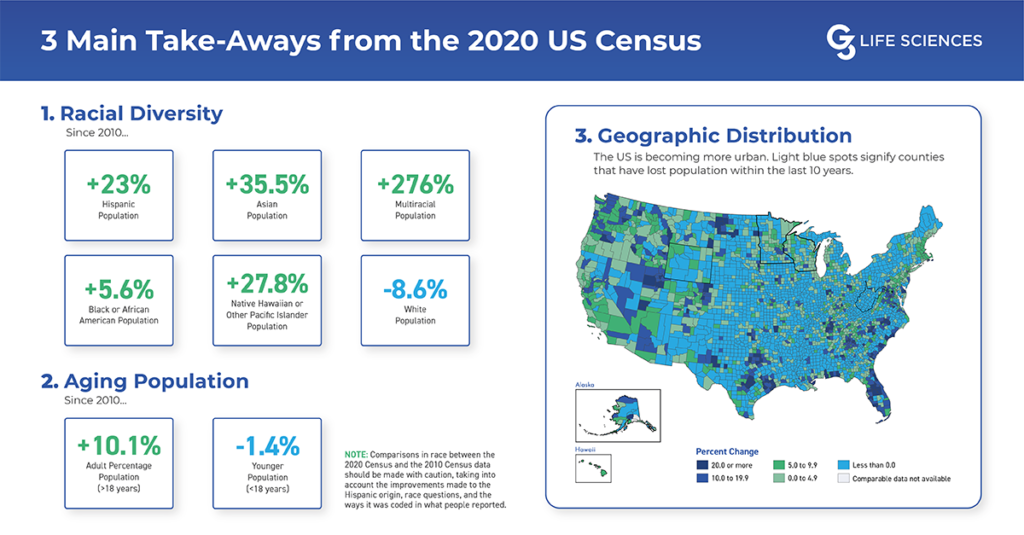In August 2021, the 2020 United States census was released, highlighting demographic data about the country’s population background change since 2010.
After sorting through the data, it’s clear there were major shifts over the past decade. From these changes, we’ve outlined three major takeaways.
1) On Race: More Diverse
Since 2010, there has been an increase in all racial minority populations across the US. The largest increase was for those who identified as two or more races, or “multiracial,” which saw a 276% jump from 2010.
Other populations, such as those who identify as Asian, Hispanic, and Native Hawaiian, also saw substantial increases.
For the first time since the original census was released in 1790, the white population decreased. And it did so quite drastically—by 8.6% to be exact.
Some believe the reason for the decrease was that more people are identifying as multiracial. This is due to the way race-related questions were asked on the census. In fact, the US Census Bureau released a warning with the new demographic data, stating:
It is important to note that these data comparisons between the 2020 Census and 2010 Census race data should be made with caution, taking into account the improvements we have made to the Hispanic origin and race questions and the ways we code what people tell us.
2) On Population Ages: Ups and Downs
Over the past decade, the adult population percentage increased by 10.1%. The younger population, on the other hand, saw a 1.4% decrease.
The adult population’s growth rate was still higher than the rate for the country’s total population, increasing by 7.4%. This shows that the country has an aging population. Additionally, this increase is actually the slowest rate of overall growth since the 1930s during the Great Depression.
According to a US Census Bureau report released in August 2021, nearly 20% of older adults between the ages of 55–64 did not have children. That number is expected to increase in the coming years.
3) On Geographic Distribution: More Urban
The 2020 census data shows that the distribution of populations across the US has continued to shift from micropolitan to metropolitan. Micro areas have a population between 10,000 and 50,000, while metro areas have more than 50,000 people.
Approximately 80% of metro areas with large suburbs and cities saw population increases, while smaller, more rural counties decreased.
In addition, 86% of the population lived in metropolitan statistical areas in 2020—up from 85% in 2010. Another 8% lived in micropolitan statistical areas—down from 9% in 2010. The remaining 7% lived outside the core-based statistical area, meaning outside the regions defined as metropolitan or micropolitan by the US Census Bureau. However, the distribution of those living in micropolitan areas varies greatly within the United States. For example, in 2018 Wyoming was found to have the largest percentage of its population living in micro areas (44.2%), while Rhode Island, Delaware, and New Jersey had zero micro areas.
The top 10 biggest cities in the US also grew. Here’s an outline of their population percentage increases since 2010:
- New York City, NY: 8.8 million (+7.7%)
- Los Angeles, CA: 3.9 million (+2.8%)
- Chicago, IL: 2.7 million (+1.9%)
- Houston, TX: 2.3 million (+9.8%)
- Phoenix, AZ: 1.6 million (+11.2%)
- Philadelphia, PA: 1.6 million (+5.1%)
- San Antonio, TX: 1.4 million (+8.1%)
- San Diego, CA: 1.4 million (+6.1%)
- Dallas, TX: 1.3 million (+8.9%)
- San Jose, CA: 1 million (+7.1%)
If the 2020 US census revealed anything, it’s that the US population is changing drastically. Shifts in demographic backgrounds, ages, and geographic locations affect the economy and the healthcare system. For life sciences companies, particularly those in healthcare, it’s critical to understand these changes in order to better serve your patients and consumers.
To learn how our healthcare services can help you reach your members, contact us here: https://www.theg3company.com/contact/.

